South America
.svg.png) | |
| Area | 17,840,000 km2 (6,890,000 sq mi) (4th) |
|---|---|
| Population | 420,458,044 (2016; 5th)[1] |
| Population density | 21.4/km2 (56.0/sq mi) |
| GDP (nominal) | $3.94 trillion (2017; 4th)[2] |
| GDP (PPP) | $6.57 trillion (2017; 4th)[3] |
| GDP per capita | $9,330 (2017; 4th)[4] |
| Demonym | South American |
| Countries | 12 |
| Dependencies | 4 |
| Languages | Spanish, Portuguese, English, French, Dutch, Quechua, Hindustani, Sranan Tongo, Saramaccan, other languages |
| Time zones | UTC-2 to UTC-5 |
| Largest cities |
List of cities in South America |
South America is a continent in the Western Hemisphere, mostly in the Southern Hemisphere, with a relatively small portion in the Northern Hemisphere. It may also be considered a subcontinent of the Americas,[5][6] which is how it is viewed in the Spanish and Portuguese-speaking regions of the Americas. The reference to South America instead of other regions (like Latin America or the Southern Cone) has increased in the last decades due to changing geopolitical dynamics (in particular, the rise of Brazil).[7]
It is bordered on the west by the Pacific Ocean and on the north and east by the Atlantic Ocean; North America and the Caribbean Sea lie to the northwest. It includes twelve sovereign states (Argentina, Bolivia, Brazil, Chile, Colombia, Ecuador, Guyana, Paraguay, Peru, Suriname, Uruguay, and Venezuela), a part of France (French Guiana), and a non-sovereign area (the Falkland Islands, a British Overseas Territory though this is disputed by Argentina). In addition to this, the ABC islands of the Kingdom of the Netherlands, Trinidad and Tobago, and Panama may also be considered part of South America.
South America has an area of 17,840,000 square kilometers (6,890,000 sq mi). Its population as of 2016 has been estimated at more than 420 million.[1] South America ranks fourth in area (after Asia, Africa, and North America) and fifth in population (after Asia, Africa, Europe, and North America). Brazil is by far the most populous South American country, with more than half of the continent's population, followed by Colombia, Argentina, Venezuela and Peru. In recent decades Brazil has also concentrated half of the region's GDP and has become a first regional power.[7]
Most of the population lives near the continent's western or eastern coasts while the interior and the far south are sparsely populated. The geography of western South America is dominated by the Andes mountains; in contrast, the eastern part contains both highland regions and vast lowlands where rivers such as the Amazon, Orinoco, and Paraná flow. Most of the continent lies in the tropics.
The continent's cultural and ethnic outlook has its origin with the interaction of indigenous peoples with European conquerors and immigrants and, more locally, with African slaves. Given a long history of colonialism, the overwhelming majority of South Americans speak Portuguese or Spanish, and societies and states reflect Western traditions.
Geography
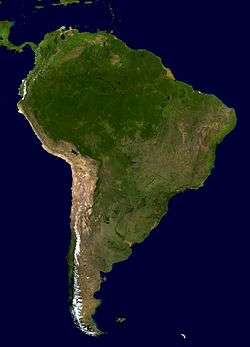
South America occupies the southern portion of the Americas. The continent is generally delimited on the northwest by the Darién watershed along the Colombia–Panama border, although some may consider the border instead to be the Panama Canal. Geopolitically and geographically[8] all of Panama – including the segment east of the Panama Canal in the isthmus – is typically included in North America alone[9][10][11] and among the countries of Central America.[12][13] Almost all of mainland South America sits on the South American Plate.
South America is home to the world's highest uninterrupted waterfall, Angel Falls in Venezuela; the highest single drop waterfall Kaieteur Falls in Guyana; the largest river (by volume), the Amazon River; the longest mountain range, the Andes (whose highest mountain is Aconcagua at 6,962 m [22,841 ft]); the driest non-polar place on earth, the Atacama Desert;[14][15][16] the largest rainforest, the Amazon Rainforest; the highest capital city, La Paz, Bolivia; the highest commercially navigable lake in the world, Lake Titicaca; and, excluding research stations in Antarctica, the world's southernmost permanently inhabited community, Puerto Toro, Chile.
South America's major mineral resources are gold, silver, copper, iron ore, tin, and petroleum. These resources found in South America have brought high income to its countries especially in times of war or of rapid economic growth by industrialized countries elsewhere. However, the concentration in producing one major export commodity often has hindered the development of diversified economies. The fluctuation in the price of commodities in the international markets has led historically to major highs and lows in the economies of South American states, often causing extreme political instability. This is leading to efforts to diversify production to drive away from staying as economies dedicated to one major export.
South America is one of the most biodiverse continents on earth. South America is home to many interesting and unique species of animals including the llama, anaconda, piranha, jaguar, vicuña, and tapir. The Amazon rainforests possess high biodiversity, containing a major proportion of the Earth's species.
Brazil is the largest country in South America, encompassing around half of the continent's land area and population. The remaining countries and territories are divided among three regions: The Andean States, the Guianas and the Southern Cone.
Outlying islands
Traditionally, South America also includes some of the nearby islands. Aruba, Bonaire, Curaçao, Trinidad, Tobago, and the federal dependencies of Venezuela sit on the northerly South American continental shelf and are often considered part of the continent. Geo-politically, the island states and overseas territories of the Caribbean are generally grouped as a part or subregion of North America, since they are more distant on the Caribbean Plate, even though San Andres and Providencia are politically part of Colombia and Aves Island is controlled by Venezuela.[11][17][18]
Other islands that are included with South America are the Galápagos Islands that belong to Ecuador and Easter Island (in Oceania but belonging to Chile), Robinson Crusoe Island, Chiloé (both Chilean) and Tierra del Fuego (split in between Chile and Argentina). In the Atlantic, Brazil owns Fernando de Noronha, Trindade and Martim Vaz, and the Saint Peter and Saint Paul Archipelago, while the Falkland Islands are governed by the United Kingdom, whose sovereignty over the islands is disputed by Argentina. South Georgia and the South Sandwich Islands may be associated with either South America or Antarctica.[19]
Climate
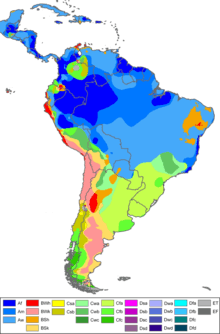
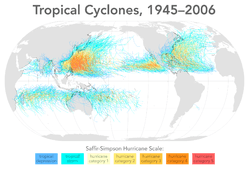
The distribution of the average temperatures in the region presents a constant regularity from the 30° of latitude south, when the isotherms tend, more and more, to be confused with the degrees of latitude.[20]
In temperate latitudes, winters are milder and summers warmer than in North America. Because its most extensive part of the continent is in the equatorial zone, the region has more areas of equatorial plains than any other region.[20]
The average annual temperatures in the Amazon basin oscillate around 27 °C, with low thermal amplitudes and high rainfall indices. Between the Maracaibo Lake and the mouth of the Orinoco, predominates an equatorial climate of the type Congolese, that also includes parts of the Brazilian territory.[20]
The east-central Brazilian plateau has a humid and warm tropical climate. The northern and eastern parts of the Argentine pampas have a humid subtropical climate with dry winters and humid summers of the Chinese type, while the western and eastern ranges have a subtropical climate of the dinaric type. At the highest points of the Andean region, climates are colder than the ones occurring at the highest point of the Norwegian fjords. In the Andean plateaus, the warm climate prevails, although it is tempered by the altitude, while in the coastal strip, there is an equatorial climate of the Guinean type. From this point until the north of the Chilean coast appear, successively, Mediterranean oceanic climate, temperate of the Breton type and, already in Tierra del Fuego, cold climate of the Siberian type.[20]
The distribution of rainfall is related to the regime of winds and air masses. In most of the tropical region east of the Andes, winds blowing from the northeast, east and southeast carry moisture from the Atlantic, causing abundant rainfall. However, due to a consistently strong wind shear and a weak Intertropical Convergence Zone, tropical cyclones are practically unknown in the South Atlantic.[21] In the Orinoco lhanos and in the Guianas plateau, the precipitation levels go from moderate to high. The Pacific coast of Colombia and northern Ecuador are rainy regions. The Atacama Desert, along this stretch of coast, is one of the driest regions in the world. The central and southern parts of Chile are subject to extratropical cyclones, and most of the Argentine Patagonia is desert. In the pampas of Argentina, Uruguay and South of Brazil the rainfall is moderate, with rains well distributed during the year. The moderately dry conditions of the Chaco oppose the intense rainfall of the eastern region of Paraguay. In the semiarid coast of the Brazilian Northeast the rains are linked to a monsoon regime.[20]
Important factors in the determination of climates are sea currents, such as the current Humboldt and Falklands. The equatorial current of the South Atlantic strikes the coast of the Northeast and there is divided into two others: the current of Brazil and a coastal current that flows to the northwest towards the Antilles, where there it moves towards northeast course thus forming the most Important and famous ocean current in the world, the Gulf Stream.[20][22]
History
Prehistory
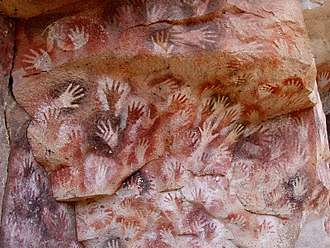
South America is believed to have been joined with Africa from the late Paleozoic Era to the early Mesozoic Era, until the supercontinent Pangaea began to rift and break apart about 225 million years ago. Therefore, South America and Africa share similar fossils and rock layers.
South America is thought to have been first inhabited by humans when people were crossing the Bering Land Bridge (now the Bering Strait) at least 15,000 years ago from the territory that is present-day Russia. They migrated south through North America, and eventually reached South America through the Isthmus of Panama.
The first evidence for the existence of the human race in South America dates back to about 9000 BC, when squashes, chili peppers and beans began to be cultivated for food in the highlands of the Amazon Basin. Pottery evidence further suggests that manioc, which remains a staple food today, was being cultivated as early as 2000 BC.[23]
By 2000 BC, many agrarian communities had been settled throughout the Andes and the surrounding regions. Fishing became a widespread practice along the coast, helping establish fish as a primary source of food. Irrigation systems were also developed at this time, which aided in the rise of an agrarian society.[23]
South American cultures began domesticating llamas, vicuñas, guanacos, and alpacas in the highlands of the Andes circa 3500 BC. Besides their use as sources of meat and wool, these animals were used for transportation of goods.[23]
Pre-Columbian civilizations
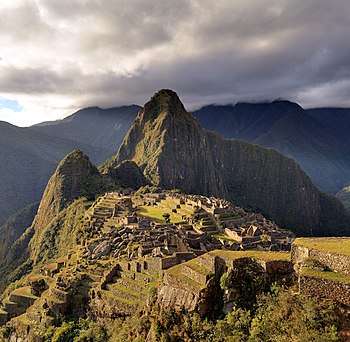
The rise of plant growing and the subsequent appearance of permanent human settlements allowed for the multiple and overlapping beginnings of civilizations in South America.
One of the earliest known South American civilizations was at Norte Chico, on the central Peruvian coast. Though a pre-ceramic culture, the monumental architecture of Norte Chico is contemporaneous with the pyramids of Ancient Egypt. Norte Chico governing class established a trade network and developed agriculture then followed by Chavín by 900 BC, according to some estimates and archaeological finds. Artifacts were found at a site called Chavín de Huantar in modern Peru at an elevation of 3,177 meters. Chavín civilization spanned 900 BC to 300 BC.
In the central coast of Peru, around the beginning of the 1st millennium AD, Moche (100 BC – 700 AD, at the northern coast of Peru), Paracas and Nazca (400 BC – 800 AD, Peru) cultures flourished with centralized states with permanent militia improving agriculture through irrigation and new styles of ceramic art. At the Altiplano, Tiahuanaco or Tiwanaku (100 BC – 1200 AD, Bolivia) managed a large commercial network based on religion.
Around the 7th century, both Tiahuanaco and Wari or Huari Empire (600–1200, Central and northern Peru) expanded its influence to all the Andean region, imposing the Huari urbanism and Tiahuanaco religious iconography.
The Muisca were the main indigenous civilization in what is now Colombia. They established the Muisca Confederation of many clans, or cacicazgos, that had a free trade network among themselves. They were goldsmiths and farmers.
Other important Pre-Columbian cultures include: the Cañaris (in south central Ecuador), Chimú Empire (1300–1470, Peruvian northern coast), Chachapoyas, and the Aymaran kingdoms (1000–1450, Western Bolivia and southern Peru).
Holding their capital at the great city of Cusco, the Inca civilization dominated the Andes region from 1438 to 1533. Known as Tawantin suyu, and "the land of the four regions," in Quechua, the Inca Empire was highly distinct and developed. Inca rule extended to nearly a hundred linguistic or ethnic communities, some 9 to 14 million people connected by a 25,000 kilometer road system. Cities were built with precise, unmatched stonework, constructed over many levels of mountain terrain. Terrace farming was a useful form of agriculture.
The Mapuche in Central and Southern Chile resisted the European and Chilean settlers, waging the Arauco War for more than 300 years.
European colonization

In 1494, Portugal and Spain, the two great maritime European powers of that time, on the expectation of new lands being discovered in the west, signed the Treaty of Tordesillas, by which they agreed, with the support of the Pope, that all the land outside Europe should be an exclusive duopoly between the two countries.
The treaty established an imaginary line along a north-south meridian 370 leagues west of the Cape Verde Islands, roughly 46° 37' W. In terms of the treaty, all land to the west of the line (known to comprise most of the South American soil) would belong to Spain, and all land to the east, to Portugal. As accurate measurements of longitude were impossible at that time, the line was not strictly enforced, resulting in a Portuguese expansion of Brazil across the meridian.
Beginning in the 1530s, the people and natural resources of South America were repeatedly exploited by foreign conquistadors, first from Spain and later from Portugal. These competing colonial nations claimed the land and resources as their own and divided it in colonies.
European infectious diseases (smallpox, influenza, measles, and typhus) – to which the native populations had no immune resistance – caused large-scale depopulation of the native population under Spanish control. Systems of forced labor, such as the haciendas and mining industry's mit'a also contributed to the depopulation. After this, African slaves, who had developed immunities to these diseases, were quickly brought in to replace them.
.jpg)
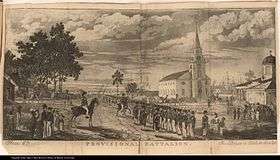
The Spaniards were committed to converting their native subjects to Christianity and were quick to purge any native cultural practices that hindered this end; however, many initial attempts at this were only partially successful, as native groups simply blended Catholicism with their established beliefs and practices. Furthermore, the Spaniards brought their language to the degree they did with their religion, although the Roman Catholic Church's evangelization in Quechua, Aymara, and Guaraní actually contributed to the continuous use of these native languages albeit only in the oral form.
Eventually, the natives and the Spaniards interbred, forming a mestizo class. At the beginning, many mestizos of the Andean region were offspring of Amerindian mothers and Spanish fathers. After independence, most mestizos had native fathers and European or mestizo mothers.
Many native artworks were considered pagan idols and destroyed by Spanish explorers; this included many gold and silver sculptures and other artifacts found in South America, which were melted down before their transport to Spain or Portugal. Spaniards and Portuguese brought the western European architectural style to the continent, and helped to improve infrastructures like bridges, roads, and the sewer system of the cities they discovered or conquered. They also significantly increased economic and trade relations, not just between the old and new world but between the different South American regions and peoples. Finally, with the expansion of the Portuguese and Spanish languages, many cultures that were previously separated became united through that of Latin American.
Guyana was first a Dutch, and then a British colony, though there was a brief period during the Napoleonic Wars when it was colonized by the French. The country was once partitioned into three parts, each being controlled by one of the colonial powers until the country was finally taken over fully by the British.
Slavery in South America

Indigenous peoples of the Americas in various European colonies were forced to work in European plantations and mines; along with African slaves who were also introduced in the proceeding centuries. The colonists were heavily dependent on indigenous labor during the initial phases of European settlement to maintain the subsistence economy, and natives were often captured by expeditions. The importation of African slaves began midway through the 16th century, but the enslavement of indigenous peoples continued well into the 17th and 18th centuries. The Atlantic slave trade brought African slaves primarily to South American colonies, beginning with the Portuguese since 1502.[24] The main destinations of this phase were the Caribbean colonies and Brazil, as European nations built up economically slave-dependent colonies in the New World. Nearly 40% of all African slaves trafficked to the Americas went to Brazil. An estimated 4.9 million slaves from Africa came to Brazil during the period from 1501 to 1866.[25][26]
While the Portuguese, English and French settlers enslaved mainly African blacks, the Spaniards became very disposed of the natives. In 1750 Portugal abolished native slavery in the colonies because they considered them unfit for labour and began to import even more African slaves. Slaves were brought to the mainland on so-called slave ships, under inhuman conditions and ill-treatment, and those who survived were sold into the slave markets.
After independence, all South American countries maintained slavery for some time. The first South American country to abolish slavery was Chile in 1823, Uruguay in 1830, Bolivia in 1831, Colombia and Ecuador in 1851, Argentina in 1853, Peru and Venezuela in 1854, Paraguay in 1869, and in 1888 Brazil was the last South American nation and the last country in western world to abolish slavery.
Independence from Spain and Portugal
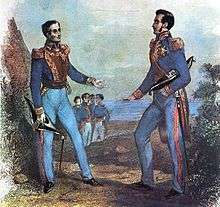
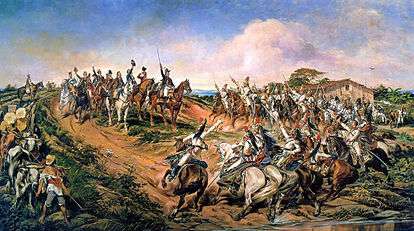
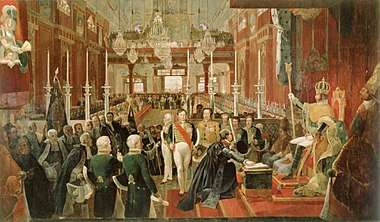
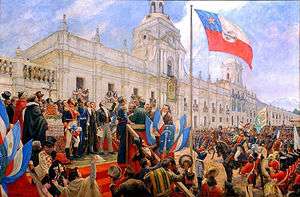
The European Peninsular War (1807–1814), a theater of the Napoleonic Wars, changed the political situation of both the Spanish and Portuguese colonies. First, Napoleon invaded Portugal, but the House of Braganza avoided capture by escaping to Brazil. Napoleon also captured King Ferdinand VII of Spain, and appointed his own brother instead. This appointment provoked severe popular resistance, which created Juntas to rule in the name of the captured king.
Many cities in the Spanish colonies, however, considered themselves equally authorized to appoint local Juntas like those of Spain. This began the Spanish American wars of independence between the patriots, who promoted such autonomy, and the royalists, who supported Spanish authority over the Americas. The Juntas, in both Spain and the Americas, promoted the ideas of the Enlightenment. Five years after the beginning of the war, Ferdinand VII returned to the throne and began the Absolutist Restoration as the royalists got the upper hand in the conflict.
The independence of South America was secured by Simón Bolívar (Venezuela) and José de San Martín (Argentina), the two most important Libertadores. Bolívar led a great uprising in the north, then led his army southward towards Lima, the capital of the Viceroyalty of Peru. Meanwhile, San Martín led an army across the Andes Mountains, along with Chilean expatriates, and liberated Chile. He organized a fleet to reach Peru by sea, and sought the military support of various rebels from the Viceroyalty of Peru. The two armies finally met in Guayaquil, Ecuador, where they cornered the Royal Army of the Spanish Crown and forced its surrender.
In the Portuguese Kingdom of Brazil, Dom Pedro I (also Pedro IV of Portugal), son of the Portuguese King Dom João VI, proclaimed the independent Kingdom of Brazil in 1822, which later became the Empire of Brazil. Despite the Portuguese loyalties of garrisons in Bahia, Cisplatina and Pará, independence was diplomatically accepted by the crown in Portugal in 1825, on condition of a high compensation paid by Brazil mediatized by the United Kingdom.
Nation-building and fragmentation
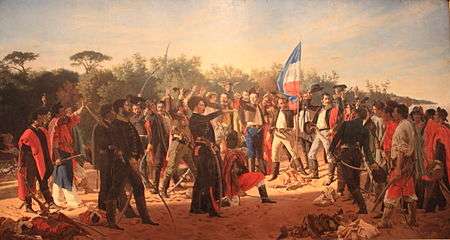
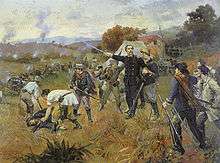
The newly independent nations began a process of fragmentation, with several civil and international wars. However, it was not as strong as in Central America. Some countries created from provinces of larger countries stayed as such up to modern times (such as Paraguay or Uruguay), while others were reconquered and reincorporated into their former countries (such as the Republic of Entre Ríos and the Riograndense Republic).
The first separatist attempt was in 1820 by the Argentine province of Entre Ríos, led by a caudillo.[27] In spite of the "Republic" in its title, General Ramírez, its caudillo, never really intended to declare an independent Entre Rios. Rather, he was making a political statement in opposition to the monarchist and centralist ideas that back then permeated Buenos Aires politics. The "country" was reincorporated at the United Provinces in 1821.
In 1825 the Cisplatine Province declared its independence from the Empire of Brazil, which led to the Cisplatine War between the imperials and the Argentine from the United Provinces of the Río de la Plata to control the region. Three years later, the United Kingdom intervened in the question by proclaiming a tie and creating in the former Cisplatina a new independent country: The Oriental Republic of Uruguay.
Later in 1836, while Brazil was experiencing the chaos of the regency, Rio Grande do Sul proclaimed its independence motivated by a tax crisis. With the anticipation of the coronation of Pedro II to the throne of Brazil, the country could stabilize and fight the separatists, which the province of Santa Catarina had joined in 1839. The Conflict came to an end by a process of compromise by which both Riograndense Republic and Juliana Republic were reincorporated as provinces in 1845.[28][29]
The Peru–Bolivian Confederation, a short-lived union of Peru and Bolivia, was blocked by Chile in the War of the Confederation (1836–1839) and again during the War of the Pacific (1879–1883). Paraguay was virtually destroyed by Argentina and Brazil in the Paraguayan War.
Wars and conflicts
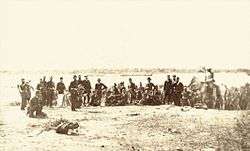
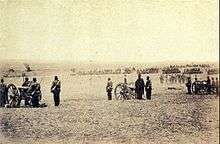
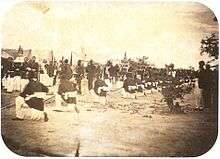

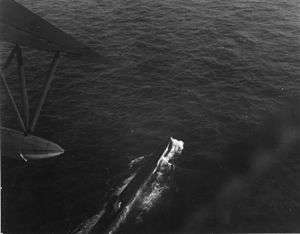
South American history in early 19th century was built almost exclusively on wars. Despite the Spanish American wars of independence and the Brazilian War of Independence, the new nations quickly began to suffer with internal conflicts and wars among themselves.
In 1825 the proclamation of independence of Cisplatina led to the Cisplatine War between historical rivals the Empire of Brazil and the United Provinces of the Río de la Plata, Argentina's predecessor. The result was a stalemate, ending with the British arranging for the independence of Uruguay. Soon after, another Brazilian province proclaimed its independence leading to the Ragamuffin War which Brazil won.
Between 1836 and 1839 the War of the Confederation broke out between the short-lived Peru-Bolivian Confederation and Chile, with the support of the Argentine Confederation. The war was fought mostly in the actual territory of Peru and ended with a Confederate defeat and the dissolution of the Confederacy and annexation of many territories by Argentina.
Meanwhile, the Argentine Civil Wars plagued Argentina since its independence. The conflict was mainly between those who defended the centralization of power in Buenos Aires and those who defended a confederation. During this period it can be said that "there were two Argentines": the Argentine Confederation and the Argentine Republic. At the same time the political instability in Uruguay led to the Uruguayan Civil War among the main political factions of the country. All this instability in the platine region interfered with the goals of other countries such as Brazil, which was soon forced to take sides. In 1851 the Brazilian Empire, supporting the centralizing unitarians, and the Uruguayan government invaded Argentina and deposed the caudillo, Juan Manuel Rosas, who ruled the confederation with an iron hand. Although the Platine War did not put an end to the political chaos and civil war in Argentina, it brought temporary peace to Uruguay where the Colorados faction won, supported by the Brazilian Empire, British Empire, French Empire and the Unitarian Party of Argentina.[30]
Peace lasted only a short time: in 1864 the Uruguayan factions faced each other again in the Uruguayan War. The Blancos supported by Paraguay started to attack Brazilian and Argentine farmers near the borders. The Empire made an initial attempt to settle the dispute between Blancos and Colorados without success. In 1864, after a Brazilian ultimatum was refused, the imperial government declared that Brazil's military would begin reprisals. Brazil declined to acknowledge a formal state of war, and, for most of its duration, the Uruguayan–Brazilian armed conflict was an undeclared war which led to the deposition of the Blancos and the rise of the pro-Brazilian Colorados to power again. This angered the Paraguayan government, which even before the end of the war invaded Brazil, beginning the biggest and deadliest war in both South American and Latin American histories: the Paraguayan War.
The Paraguayan War began when the Paraguayan dictator Francisco Solano López ordered the invasion of the Brazilian provinces of Mato Grosso and Rio Grande do Sul. His attempt to cross Argentinian territory without Argentinian approval led the pro-Brazilian Argentine government into the war. The pro-Brazilian Uruguayan government showed its support by sending troops. In 1865 the three countries signed the Treaty of the Triple Alliance against Paraguay. At the beginning of the war, the Paraguayans took the lead with several victories, until the Triple Alliance organized to repel the invaders and fight effectively. This was the second total war experience in the world after the American Civil War. It was deemed the greatest war effort in the history of all participating countries, taking almost 6 years and ending with the complete devastation of Paraguay. The country lost 40% of its territory to Brazil and Argentina and lost 60% of its population, including 90% of the men. The dictator Lopez was killed in battle and a new government was instituted in alliance with Brazil, which maintained occupation forces in the country until 1876.[31]
The last South American war in the 19th century was the War of the Pacific with Bolivia and Peru on one side and Chile on the other. In 1879 the war began with Chilean troops occupying Bolivian ports, followed by Bolivia declaring war on Chile which activated an alliance treaty with Peru. The Bolivians were completely defeated in 1880 and Lima was occupied in 1881. The peace was signed with Peru in 1883 while a truce was signed with Bolivia in 1884. Chile annexed territories of both countries leaving Bolivia with no path to the sea.[32]
In the new century, as wars became less violent and less frequent, Brazil entered into a small conflict with Bolivia for the possession of the Acre, which was acquired by Brazil in 1902. In 1917 Brazil declared war on the Central Powers and join the allied side in the World War I, sending a small fleet to the Mediterranean Sea and some troops to be integrated with the British and French troops. Brazil was the only South American country that fought in WWI.[33][34] Later in 1932 Colombia and Peru entered a short armed conflict for territory in the Amazon. In the same year Paraguay declared war on Bolivia for possession of the Chaco, in a conflict that ended three years later with Paraguay's victory. Between 1941 and 1942 Peru and Ecuador fought decisively for territories claimed by both that were annexed by Peru, usurping Ecuador's frontier with Brazil.[35]
Also in this period the first naval battle of World War II was fought on the continent, in the River Plate, between British forces and German submarines.[36] The Germans still made numerous attacks on Brazilian ships on the coast, causing Brazil to declare war on the Axis powers in 1942, being the only South American country to fight in this war (and in both World Wars). Brazil sent naval and air forces to combat German and Italian submarines off the continent and throughout the South Atlantic, in addition to sending an expeditionary force to fight in the Italian Campaign.[37][38][37]
A brief war was fought between Argentina and the UK in 1982, following an Argentine invasion of the Falkland Islands, which ended with an Argentine defeat. The last international war to be fought on South American soil was the 1995 Cenepa War between Ecuador and the Peru along their mutual border.
Rise and fall of military dictatorships


Wars became less frequent in the 20th century, with Bolivia-Paraguay and Peru-Ecuador fighting the last inter-state wars. Early in the 20th century, the three wealthiest South American countries engaged in a vastly expensive naval arms race which was catalyzed by the introduction of a new warship type, the "dreadnought". At one point, the Argentine government was spending a fifth of its entire yearly budget for just two dreadnoughts, a price that did not include later in-service costs, which for the Brazilian dreadnoughts was sixty percent of the initial purchase.[39][40]
The continent became a battlefield of the Cold War in the late 20th century. Some democratically elected governments of Argentina, Brazil, Chile, Uruguay and Paraguay were overthrown or displaced by military dictatorships in the 1960s and 1970s. To curtail opposition, their governments detained tens of thousands of political prisoners, many of whom were tortured and/or killed on inter-state collaboration. Economically, they began a transition to neoliberal economic policies. They placed their own actions within the US Cold War doctrine of "National Security" against internal subversion. Throughout the 1980s and 1990s, Peru suffered from an internal conflict.
Argentina and Britain fought the Falklands War in 1982.
Colombia has had an ongoing, though diminished internal conflict, which started in 1964 with the creation of Marxist guerrillas (FARC-EP) and then involved several illegal armed groups of leftist-leaning ideology as well as the private armies of powerful drug lords. Many of these are now defunct, and only a small portion of the ELN remains, along with the stronger, though also greatly reduced, FARC. These leftist groups smuggle narcotics out of Colombia to fund their operations, while also using kidnapping, bombings, land mines and assassinations as weapons against both elected and non-elected citizens.
Revolutionary movements and right-wing military dictatorships became common after World War II, but since the 1980s, a wave of democratization passed through the continent, and democratic rule is widespread now.[41] Nonetheless, allegations of corruption are still very common, and several countries have developed crises which have forced the resignation of their governments, although, on most occasions, regular civilian succession has continued.
.jpg)
International indebtedness turned into a severe problem in the late 1980s, and some countries, despite having strong democracies, have not yet developed political institutions capable of handling such crises without resorting to unorthodox economic policies, as most recently illustrated by Argentina's default in the early 21st century.[42] The last twenty years have seen an increased push towards regional integration, with the creation of uniquely South American institutions such as the Andean Community, Mercosur and Unasur. Notably, starting with the election of Hugo Chávez in Venezuela in 1998, the region experienced what has been termed a pink tide – the election of several leftist and center-left administrations to most countries of the area, except for the Guianas and Colombia.
Countries and territories
| Flag | Arms | Country or territory with flag |
Capital | Area (km²)[43] (sq mi) |
Population (2016 est.)[1] |
Population density per km2 (per sq mi) |
|---|---|---|---|---|---|---|
| Argentina | Buenos Aires | 2,766,890 km2 (1,068,300 sq mi) | 43,847,430 | 14.3/km² (37/sq mi) | ||
| Bolivia | La Paz and Sucre[44] | 1,098,580 km2 (424,160 sq mi) | 10,887,882 | 8.4/km² (21.8/sq mi) | ||
| Bouvet Island (Norway)[45] | 49 km2 (19 sq mi) | 0 | 0.0/km² (0/sq mi) | |||
| Brazil | Brasília | 8,514,877 km2 (3,287,612 sq mi) | 207,652,865 | 22.0/km² (57/sq mi) | ||
| Chile[46] | Santiago | 756,950 km2 (292,260 sq mi) | 17,909,754 | 22/km² (57/sq mi) | ||
| Colombia | Bogotá | 1,141,748 km2 (440,831 sq mi) | 48,653,419 | 40/km² (103.6/sq mi) | ||
| Ecuador | Quito | 283,560 km2 (109,480 sq mi) | 16,385,068 | 53.8/km² (139.3/sq mi) | ||
| Falkland Islands (United Kingdom)[47] | Stanley | 12,173 km2 (4,700 sq mi) | 2,910 | 0.26/km² (0.7/sq mi) | ||
| French Guiana (France) | Cayenne (Préfecture) | 91,000 km2 (35,000 sq mi) | 275,713 | 2.7/km² (5.4/sq mi) | ||
| Guyana | Georgetown | 214,999 km2 (83,012 sq mi) | 773,303 | 3.5/km² (9.1/sq mi) | ||
| Paraguay | Asunción | 406,750 km2 (157,050 sq mi) | 6,725,308 | 15.6/km² (40.4/sq mi) | ||
| Peru | Lima | 1,285,220 km2 (496,230 sq mi) | 31,773,839 | 22/km² (57/sq mi) | ||
| South Georgia and the South Sandwich Islands (United Kingdom)[48] | King Edward Point[49] | 3,093 km2 (1,194 sq mi) | 20 | 0/km² (0/sq mi) | ||
| Suriname | Paramaribo | 163,270 km2 (63,040 sq mi) | 558,368 | 3/km² (7.8/sq mi) | ||
| Uruguay | Montevideo | 176,220 km2 (68,040 sq mi) | 3,444,006 | 19.4/km² (50.2/sq mi) | ||
| Venezuela | Caracas | 916,445 km2 (353,841 sq mi) | 31,568,179 | 30.2/km² (72/sq mi) | ||
| Total | 17,824,513 | 420,458,044 | 21.5/km² | |||
Politics
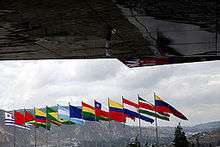
Historically, the Hispanic countries were founded as Republican dictatorships led by caudillos. Brazil was the only exception, being a constitutional monarchy for its first 67 years of independence, until a coup d'état proclaimed a republic. In the late 19th century, the most democratic countries were Brazil,[50] Chile, Argentina and Uruguay.[51]
In the interwar period, nationalism grew stronger on the continent, influenced by countries like Nazi Germany and Fascist Italy. A series of authoritarian rules broke out in South American countries with views bringing them closer to the Axis Powers,[52] like Vargas's Brazil or Perón's Argentina. In the late 20th century, during the Cold War, many countries became military dictatorships under American tutelage in attempts to avoid the influence of the Soviet Union. After the fall of the authoritarian regimes, these countries became democratic republics.
During the first decade of the 21st century, South American governments have drifted to the political left, with leftist leaders being elected in Chile, Uruguay, Brazil, Argentina, Ecuador, Bolivia, Paraguay, Peru and Venezuela. Most South American countries are making increasing use of protectionist policies, helping local development.
All South American countries are presidential republics with the exceptions of Peru, which is a semi-presidential republic, and Suriname, a parliamentary republic. French Guiana is a French overseas department, while the Falkland Islands and South Georgia and the South Sandwich Islands are British overseas territories. It is currently the only inhabited continent in the world without monarchies; the Empire of Brazil existed during the 19th century and there was an unsuccessful attempt to establish a Kingdom of Araucanía and Patagonia in southern Argentina and Chile. Also in the twentieth century, Suriname was established as a constituent kingdom of the Kingdom of the Netherlands and Guyana retained the British monarch as head of state for 4 years after its independence.
Recently, an intergovernmental entity has been formed which aims to merge the two existing customs unions: Mercosur and the Andean Community, thus forming the third-largest trade bloc in the world.[53] This new political organization, known as Union of South American Nations, seeks to establish free movement of people, economic development, a common defense policy and the elimination of tariffs.
Demographics
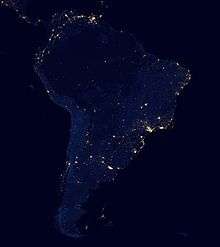
South America has over 420 million[1] inhabitants and a population growth rate of about 0.6% per year. There are several areas of sparse demographics such as tropical forests, the Atacama Desert and the icy portions of Patagonia. On the other hand, the continent presents regions of high population density, such as the great urban centers. The population is formed by descendants of Europeans (mainly Spaniards, Portuguese and Italians), Africans and indigenous peoples. There is a high percentage of mestizos that vary greatly in composition by place. There is also a minor population of Asians, especially in Brazil. The two main languages are by far Spanish and Portuguese, followed by French, English and Dutch in smaller numbers. Economically, Brazil, Argentina and Chile are the wealthiest and most developed nations in the continent.
Language
.svg.png)
Spanish and Portuguese are the most spoken languages in South America, with approximately 200 million speakers each. Spanish is the official language of most countries, along with other native languages in some countries. Portuguese is the official language of Brazil. Dutch is the official language of Suriname; English is the official language of Guyana, although there are at least twelve other languages spoken in the country, including Portuguese, Chinese, Hindustani and several native languages.[54] English is also spoken in the Falkland Islands. French is the official language of French Guiana and the second language in Amapá, Brazil.
Indigenous languages of South America include Quechua in Peru, Bolivia, Ecuador, Argentina, Chile and Colombia; Wayuunaiki in northern Colombia (La Guajira) and northwestern Venezuela (Zulia); Guaraní in Paraguay and, to a much lesser extent, in Bolivia; Aymara in Bolivia, Peru, and less often in Chile; and Mapudungun is spoken in certain pockets of southern Chile and, more rarely, Argentina. At least three South American indigenous languages (Quechua, Aymara, and Guarani) are recognized along with Spanish as national languages.
Other languages found in South America include Hindustani and Javanese in Suriname; Italian in Argentina, Brazil, Uruguay, Venezuela and Chile; and German in certain pockets of Argentina, Brazil, and Chile. German is also spoken in many regions of the southern states of Brazil, Riograndenser Hunsrückisch being the most widely spoken German dialect in the country; among other Germanic dialects, a Brazilian form of East Pomeranian is also well represented and is experiencing a revival. Welsh remains spoken and written in the historic towns of Trelew and Rawson in the Argentine Patagonia. There are also small clusters of Japanese-speakers in Brazil, Colombia and Peru. Arabic speakers, often of Lebanese, Syrian, or Palestinian descent, can be found in Arab communities in Argentina, Colombia, Brazil, Venezuela and in Paraguay.[55]
Religion
An estimated 90% of South Americans are Christians[56] (82% Roman Catholic, 8% other Christian denominations mainly traditional Protestants and Evangelicals but also Orthodox), accounting for ca. 19% of Christians worldwide.
Crypto-Jews or Marranos, conversos, and Anusim were an important part of colonial life in Latin America.
Both Buenos Aires, Argentina and São Paulo, Brazil figure among the largest Jewish populations by urban area.
Japanese Buddhism, Shintoism, and Shinto-derived Japanese New Religions are common in Brazil and Peru. Korean Confucianism is especially found in Brazil while Chinese Buddhism and Chinese Confucianism have spread throughout the continent.
Kardecist Spiritism can be found in several countries.
Part of Religions in South America (2013):[57]
| Countries | Christians | Roman Catholics | Other Christians | No religion (atheists and agnostics) |
|---|---|---|---|---|
| Argentina | 88% | 77% | 11% | 11% |
| Bolivia | 96% | 74% | 22% | 4% |
| Brazil | 86% | 64% | 22% | 9% |
| Chile | 70% | 57% | 13% | 25% |
| Colombia | 92% | 80% | 12% | 7% |
| Paraguay | 96% | 87% | 9% | 2% |
| Peru | 94% | 81% | 13% | 3% |
| Suriname | 51% | 29% | 22% | 5% |
| Uruguay | 58% | 47% | 11% | 41% |
| Venezuela | 88% | 71% | 17% | 8% |
Ethnic demographics
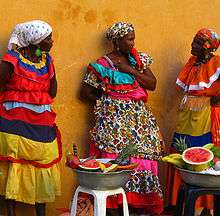
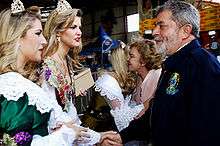
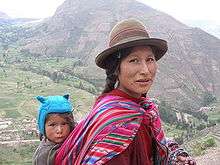
Genetic admixture occurs at very high levels in South America. In Argentina, the European influence accounts for 65–79% of the genetic background, Amerindian for 17–31% and sub-Saharan African for 2–4%. In Colombia, the sub-Saharan African genetic background varied from 1% to 89%, while the European genetic background varied from 20% to 79%, depending on the region. In Peru, European ancestries ranged from 1% to 31%, while the African contribution was only 1% to 3%.[58] The Genographic Project determined the average Peruvian from Lima had about 28% European ancestry, 68% Native American, 2% Asian ancestry and 2% sub-Saharan African.[59]
Descendants of indigenous peoples, such as the Quechua and Aymara, or the Urarina[60] of Amazonia make up the majority of the population in Bolivia (56%) and, per some sources, in Peru (44%).[61][62] In Ecuador, Amerindians are a large minority that comprises two-fifths of the population. The native European population is also a significant element in most other former Portuguese colonies.
People who identify as of primarily or totally European descent, or identify their phenotype as corresponding to such group, are more of a majority in Argentina,[63] and Uruguay[64] and more than half of the population of Chile (64.7%)[65] and (48.4%) in Brazil.[66][67][68] In Venezuela, according to the national census 42% of the population is primarily native Spanish, Italian and Portuguese descendants.[69] In Colombia, people who identify as European descendant are about 37%.[70][71] In Peru, European descendants are the third group in number (15%).[72]
Mestizos (mixed European and Amerindian) are the largest ethnic group in Paraguay, Venezuela, Colombia[70] and Ecuador and the second group in Peru.
South America is also home to one of the largest populations of Africans. This group is significantly present in Brazil, Colombia, Guyana, Suriname, French Guiana, Venezuela and Ecuador.
Brazil followed by Peru have the largest Japanese, Korean and Chinese communities in South America.[73] East Indians form the largest ethnic group in Guyana and Suriname.[74]
| Country | Amerindians | White people | Mestizos | Mulatos | Black people | Zambos | Asian people |
|---|---|---|---|---|---|---|---|
| Argentina | 1% | 85% | 14% | 0% | 0% | 0% | 0% |
| Bolivia | 55% | 12% | 30% | 2% | 0% | <1% | 0% |
| Brazil | <1% | 48% | 23% | 20% | 8% | 0% | 1.% |
| Chile | 3% | 64% | 33% | 0% | 0% | 0% | 0% |
| Colombia | 2% | 37% | 49% | 8% | 2% | 0% | 0% |
| Ecuador | 39% | 10% | 41% | 5% | 5% | 0% | 0% |
| Paraguay | 3% | 20% | 75% | 4% | 0% | 0% | 0% |
| Peru | 45% | 15% | 35% | 2% | 0% | 0% | 3% |
| Uruguay | 0% | 88% | 8% | 4% | 0% | 0% | 0% |
| Venezuela | 3% | 43% | 60% | 8% | 2% | 0% | 1% |
Indigenous people
In many places indigenous people still practice a traditional lifestyle based on subsistence agriculture or as hunter-gatherers. There are still some uncontacted tribes residing in the Amazon Rainforest.[77]
- Aguarunas
- Alacalufe
- Arawaks
- Ashanincas
- Atacameños
- Awá
- Aymara – lives in the Altiplano of Bolivia, Argentina, Chile and Peru. Their language is co-official in Peru and Bolivia. Traditional lifestyle includes llama herding.
- Banawa
- Cañaris
- Caiapos
- Chibcha
- Cocama
- Chayahuita
- Diaguita
- Enxet
- Gê,
- Guaraní – lives in Paraguay where the Guarani language is co-official with Spanish.
- Juris
- Kuna live on the Colombia–Panama border.
- Mapuche – lives mainly in southern Chile and Argentina.
- Matsés
- Pehuenche – a branch of Mapuches that lived in the Andean valleys of southern (see Araucanian).
- Quechuas – makes up a large part of the population of Peru, Ecuador and Bolivia. Are diverse as an ethnic group. The Incas spoke Southern Quechua.
- Selknam
- Shipibo
- Shuar (see Jívaro).
- Tupi
- Urarina
- Wai-Wai
- Wayuu
- Xucuru
- Yaghan
- Yagua
- Yąnomamö
- Zaparos
Populace
The most populous country in South America is Brazil with 207.7 million people. The second largest country is Colombia with a population of 48,653,419. Argentina is the third most populous country with 43,847,430.
While Brazil, Argentina, and Colombia maintain the largest populations, large city populations are not restricted to those nations. The largest cities in South America, by far, are São Paulo, Bogotá, and Lima. These cities are the only cities on the continent to exceed eight million, and three of five in the Americas. Next in size are Rio de Janeiro, Santiago, Caracas, Buenos Aires and Salvador.
Five of the top ten metropolitan areas are in Brazil. These metropolitan areas all have a population of above 4 million and include the São Paulo metropolitan area, Rio de Janeiro metropolitan area, and Belo Horizonte metropolitan area. Whilst the majority of the largest metropolitan areas are within Brazil, Argentina is host to the second largest metropolitan area by population in South America: the Buenos Aires metropolitan region is above 13 million inhabitants.
South America has also been witness to the growth of megapolitan areas. In Brazil four megaregions exist including the Expanded Metropolitan Complex of São Paulo with more than 32 million inhabitants. The others are the Greater Rio, Greater Belo Horizonte and Greater Porto Alegre. Colombia also has four megaregions which comprise 72% of its population, followed by Venezuela, Argentina and Peru which are also homes of megaregions.
The top ten largest South American metropolitan areas by population as of 2015, based on national census numbers from each country:
| Metro Area | Population | Area | Country |
| São Paulo | 21,090,792 | 7,947 km2 (3,068 sq mi) | Brazil |
| Buenos Aires | 13,693,657 | 3,830 km2 (1,480 sq mi) | Argentina |
| Rio de Janeiro | 13,131,431 | 6,744 km2 (2,604 sq mi) | Brazil |
| Lima | 9,904,727 | 2,819 km2 (1,088 sq mi) | Peru |
| Bogotá | 9,800,225 | 4,200 km2 (1,600 sq mi) | Colombia |
| Santiago | 6,683,852 | 15,403 km2 (5,947 sq mi) | Chile |
| Belo Horizonte | 5,829,923 | 9,467 km2 (3,655 sq mi) | Brazil |
| Caracas | 5,322,310 | 4,715 km2 (1,820 sq mi) | Venezuela |
| Porto Alegre | 4,258,926 | 10,232 km2 (3,951 sq mi) | Brazil |
| Brasilia | 4,201,737 | 56,433 km2 (21,789 sq mi) | Brazil |
2015 Census figures.
Economy
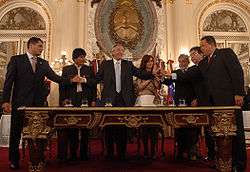


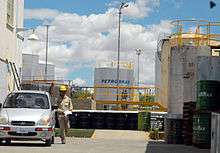
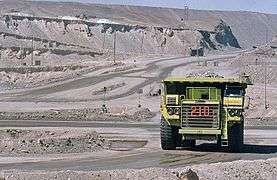
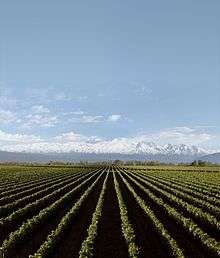
South America relies less on the export of both manufactured goods and natural resources than the world average; merchandise exports from the continent were 16% of GDP on an exchange rate basis, compared to 25% for the world as a whole.[78] Brazil (the seventh largest economy in the world and the largest in South America) leads in terms of merchandise exports at $251 billion, followed by Venezuela at $93 billion, Chile at $86 billion, and Argentina at $84 billion.[78]
Since 1930, the continent has experienced remarkable growth and diversification in most economic sectors. Most agricultural and livestock products are destined for the domestic market and local consumption. However, the export of agricultural products is essential for the balance of trade in most countries.[79]
The main agrarian crops are export crops, such as soy and wheat. The production of staple foods such as vegetables, corn or beans is large, but focused on domestic consumption. Livestock raising for meat exports is important in Argentina, Paraguay, Uruguay and Colombia. In tropical regions the most important crops are coffee, cocoa and bananas, mainly in Brazil, Colombia and Ecuador. Traditionally, the countries producing sugar for export are Peru, Guyana and Suriname, and in Brazil, sugar cane is also used to make ethanol. On the coast of Peru, northeast and south of Brazil, cotton is grown. Fifty percent of the South American surface is covered by forests, but timber industries are small and directed to domestic markets. In recent years, however, transnational companies have been settling in the Amazon to exploit noble timber destined for export. The Pacific coastal waters of South America are the most important for commercial fishing. The anchovy catch reaches thousands of tons, and tuna is also abundant (Peru is a major exporter). The capture of crustaceans is remarkable, particularly in northeastern Brazil and Chile.[79]
Only Brazil and Argentina are part of the G20 (industrial countries), while only Brazil is part of the G8+5 (the most powerful and influential nations in the world). In the tourism sector, a series of negotiations began in 2005 to promote tourism and increase air connections within the region. Punta del Este, Florianópolis and Mar del Plata are among the most important resorts in South America.[79]
The most industrialized countries in South America are Brazil, Argentina, Chile, Colombia, Venezuela and Uruguay respectively. These countries alone account for more than 75 percent of the region's economy and add up to a GDP of more than US$3.0 trillion. Industries in South America began to take on the economies of the region from the 1930s when the Great Depression in the United States and other countries of the world boosted industrial production in the continent. From that period the region left the agricultural side behind and began to achieve high rates of economic growth that remained until the early 1990s when they slowed due to political instabilities, economic crises and neoliberal policies.[79]
Since the end of the economic crisis in Brazil and Argentina that occurred in the period from 1998 to 2002, which has led to economic recession, rising unemployment and falling population income, the industrial and service sectors have been recovering rapidly. Chile, Argentina and Brazil have recovered fastest, growing at an average of 5% per year. All of South America after this period has been recovering and showing good signs of economic stability, with controlled inflation and exchange rates, continuous growth, a decrease in social inequality and unemployment–factors that favor industry.[79]
The main industries are: electronics, textiles, food, automotive, metallurgy, aviation, naval, clothing, beverage, steel, tobacco, timber, chemical, among others. Exports reach almost US$400 billion annually, with Brazil accounting for half of this.[79]
The economic gap between the rich and poor in most South American nations is larger than on most other continents. The richest 10% receive over 40% of the nation's income in Bolivia, Brazil, Chile, Colombia, and Paraguay,[80] while the poorest 20% receive 3% or less in Bolivia, Brazil, and Colombia.[81] This wide gap can be seen in many large South American cities where makeshift shacks and slums lie in the vicinity of skyscrapers and upper-class luxury apartments; nearly one in nine South Americans live on less than $2 per day (on a purchasing power parity basis).[82]
| Country | GDP (nominal) in 2017[83] |
GDP (PPP) in 2017[83] |
GDP (PPP) per capita in 2017[83] |
Merchandise exports ($bn), 2011[78] |
HDI in 2014 (rank)[84] |
Percent with less than $2 (PPP) per person per day |
|---|---|---|---|---|---|---|
| Argentina | 628,935 | 912,816 | 20,707 | 83.7 | 0.820 | 2.6 |
| Bolivia | 39,267 | 83,608 | 7,552 | 9.1 | 0.662 | 24.9 |
| Brazil | 2,140,940 | 3,216,031 | 15,485 | 250.8 | 0.752 | 10.8 |
| Chile | 251,220 | 455,941 | 24,796 | 86.1 | 0.833 | 2.7 |
| Colombia | 306,439 | 720,151 | 14,609 | 56.5 | 0.720 | 15.8 |
| Ecuador | 97,362 | 184,629 | 11,004 | 22.3 | 0.732 | 10.6 |
| Falkland Islands[85] (UK) | 165 | 165 | 55,400 | 0.1 | ||
| French Guiana[86] (France) | 4,456 | 4,456 | 19,728 | 1.3 | ||
| Guyana | 3,591 | 6,398 | 8,306 | 0.9 | 0.636 | 18.0 |
| Paraguay | 28,743 | 68,005 | 9,779 | 9.8 | 0.679 | 13.2 |
| Peru | 285,032 | 469,803 | 13,501 | 46.3 | 0.734 | 12.7 |
| Suriname | 3,641 | 7,961 | 13,934 | 1.6 | 0.714 | 27.2 |
| Uruguay | 58,123 | 77,800 | 22,271 | 8.0 | 0.793 | 2.2 |
| Venezuela | 251,589 | 404,109 | 12,856 | 92.6 | 0.762 | 12.9 |
| Total | 3,836,569 | 6,642,623 | 17,852 | 669.1 | 0.729 | 11.3 |
Economically largest cities as of 2014
| Rank | City | Country | GDP in Int$ bn[87] | Population (mil)[88] | GDP per capita |
|---|---|---|---|---|---|
| 1 | São Paulo | Brazil | $430 | 20,847,500 | $20,650 |
| 2 | Buenos Aires | Argentina | $315 | 13,381,800 | $23,606 |
| 3 | Lima | Peru | $176 | 10,670,200 | $16,530 |
| 4 | Rio de Janeiro | Brazil | $176 | 12,234,100 | $14,176 |
| 5 | Santiago | Chile | $171 | 7,164,400 | $32,929 |
| 6 | Bogotá | Colombia | $160 | 9,800,000 | $17,497 |
| 7 | Brasília | Brazil | $141 | 3,976,500 | $35,689 |
| 8 | Belo Horizonte | Brazil | $84 | 5,595,800 | $15,134 |
| 9 | Porto Alegre | Brazil | $62 | 4,120,900 | $15,078 |
| 10 | Campinas | Brazil | $59 | 2,854,200 | $20,759 |
Tourism
Tourism has increasingly become a significant source of income for many South American countries.[89][90] Historical relics, architectural and natural wonders, a diverse range of foods and culture, vibrant and colorful cities, and stunning landscapes attract millions of tourists every year to South America. Some of the most visited places in the region are Iguazu Falls, Recife, Olinda, Machu Picchu, Bariloche, the Amazon rainforest, Rio de Janeiro, São Luís, Salvador, Fortaleza, Maceió, Buenos Aires, Florianópolis, San Ignacio Miní, Isla Margarita, Natal, Lima, São Paulo, Angel Falls, Brasília, Nazca Lines, Cuzco, Belo Horizonte, Lake Titicaca, Salar de Uyuni, Jesuit Missions of Chiquitos, Los Roques archipelago, Gran Sabana, Patagonia, Tayrona National Natural Park, Santa Marta, Bogotá, Medellín, Cartagena, Perito Moreno Glacier and the Galápagos Islands.[91][92]
In 2016 Brazil hosted the 2016 Summer Olympics.
Culture
South Americans are culturally influenced by their indigenous peoples, the historic connection with the Iberian Peninsula and Africa, and waves of immigrants from around the globe.
South American nations have a rich variety of music. Some of the most famous genres include vallenato and cumbia from Colombia, pasillo from Colombia and Ecuador, samba, bossa nova and música sertaneja from Brazil, and tango from Argentina and Uruguay. Also well known is the non-commercial folk genre Nueva Canción movement which was founded in Argentina and Chile and quickly spread to the rest of the Latin America.
People on the Peruvian coast created the fine guitar and cajon duos or trios in the most mestizo (mixed) of South American rhythms such as the Marinera (from Lima), the Tondero (from Piura), the 19th century popular Creole Valse or Peruvian Valse, the soulful Arequipan Yaravi, and the early 20th century Paraguayan Guarania. In the late 20th century, Spanish rock emerged by young hipsters influenced by British pop and American rock. Brazil has a Portuguese-language pop rock industry as well a great variety of other music genres.
The literature of South America has attracted considerable critical and popular acclaim, especially with the Latin American Boom of the 1960s and 1970s, and the rise of authors such as Mario Vargas Llosa, Gabriel García Márquez in novels and Jorge Luis Borges and Pablo Neruda in other genres. The Brazilians Machado de Assis and João Guimarães Rosa are widely regarded as the greatest Brazilian writers.
Because of South America's broad ethnic mix, South American cuisine has African, South American Indian, South Asian, East Asian, and European influences. Bahia, Brazil, is especially well known for its West African–influenced cuisine. Argentines, Chileans, Uruguayans, Brazilians, Bolivians, and Venezuelans regularly consume wine. People in Argentina, Paraguay, Uruguay, southern Chile, Bolivia and Brazil drink mate, an herb which is brewed. The Paraguayan version, terere, differs from other forms of mate in that it is served cold. Pisco is a liquor distilled from grapes in Peru and Chile. Peruvian cuisine mixes elements from Chinese, Japanese, Spanish, Italian, African, Arab, Andean, and Amazonic food.
Plastic arts
%2C_Singapore_-_20040616.jpg)
The artist Oswaldo Guayasamín (1919–1999) from Ecuador, represented with his painting style the feeling of the peoples of Latin America[93] highlighting social injustices in various parts of the world. The Colombian Fernando Botero (1932) is one of the greatest exponents of painting and sculpture that continues still active and has been able to develop a recognizable style of his own.[94] For his part, the Venezuelan Carlos Cruz-Diez has contributed significantly to contemporary art,[95] with the presence of works around the world.
Currently several emerging South American artists are recognized by international art critics: Guillermo Lorca—Chilean painter,[96][97] Teddy Cobeña—Ecuadorian sculptor and recipient of international sculpture award in France)[98][99][100] and Argentine artist Adrián Villar Rojas[101][102]—winner of the Zurich Museum Art Award among many others.
Sport
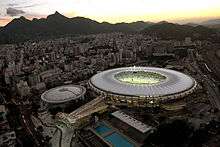
.jpg)
A wide range of sports are played in the continent of South America, with football being the most popular overall, while baseball is the most popular in Venezuela.
Other sports include basketball, cycling, polo, volleyball, futsal, motorsports, rugby (mostly in Argentina and Uruguay), handball, tennis, golf, field hockey, boxing and cricket.
South America hosted its first Olympic Games in Rio de Janeiro, Brazil in 2016 and will host the Youth Olympic Games in Buenos Aires, Argentina in 2018.
South America shares with Europe supremacy over the sport of football as all winners in FIFA World Cup history and all winning teams in the FIFA Club World Cup have come from these two continents. Brazil holds the record at the FIFA World Cup with five titles in total. Argentina and Uruguay have two titles each. So far four South American nations have hosted the tournament including the first edition in Uruguay (1930). The other three were Brazil (1950, 2014), Chile (1962), and Argentina (1978).
South America is home to the longest running international football tournament; the Copa América, which has been regularly contested since 1916. Uruguay won the Copa América a record 15 times, surpassing hosts Argentina in 2011 to reach 15 titles (they were previously equal at 14 titles each during the 2011 Copa América).
Also, in South America, a multi-sport event, the South American Games, are held every four years. The first edition was held in La Paz in 1978 and the most recent took place in Santiago in 2014.
South American Cricket Championship is an international limited-overs cricket tournament played since 1995 featuring national teams from South America and certain other invited sides including teams from North America, currently played annually but until 2013 was usually played every two seasons.
Infrastructure
Energy
Due to the diversity of topography and pluviometric precipitation conditions, the region's water resources vary enormously in different areas. In the Andes, navigation possibilities are limited, except for the Magdalena River, Lake Titicaca and the lakes of the southern regions of Chile and Argentina. Irrigation is an important factor for agriculture from northwestern Peru to Patagonia. Less than 10% of the known electrical potential of the Andes had been used until the mid-1960s.
The Brazilian Highlands has a much higher hydroelectric potential than the Andean region and its possibilities of exploitation are greater due to the existence of several large rivers with high margins and the occurrence of great differences forming huge cataracts, such as those of Paulo Afonso, Iguaçu and others. The Amazon River system has about 13,000 km of waterways, but its possibilities for hydroelectric use are still unknown.
Most of the continent's energy is generated through hydroelectric power plants, but there is also an important share of thermoelectric and wind energy. Brazil and Argentina are the only South American countries that generate nuclear power, each with two nuclear power plants. In 1991 these countries signed a peaceful nuclear cooperation agreement.
Transport
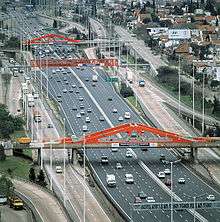
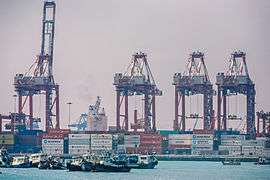
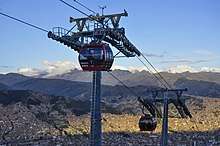
South American transportation systems are still deficient, with low kilometric densities. The region has about 1,700,000 km of highways and 100,000 km of railways, which are concentrated in the coastal strip, and the interior is still devoid of communication.
Only two railroads are continental: the Transandina, which connects Buenos Aires, in Argentina to Valparaíso, in Chile, and the Brazil–Bolivia Railroad, which makes it the connection between the port of Santos in Brazil and the city of Santa Cruz de la Sierra, in Bolivia. In addition, there is the Pan-American Highway, which crosses the Andean countries from north to south, although some stretches are unfinished.[103]
Two areas of greater density occur in the railway sector: the platinum network, which develops around the Platine region, largely belonging to Argentina, with more than 45,000 km in length; And the Southeast Brazil network, which mainly serves the state of São Paulo, state of Rio de Janeiro and Minas Gerais. Brazil and Argentina also stand out in the road sector. In addition to the modern roads that extend through northern Argentina and south-east and south of Brazil, a vast road complex aims to link Brasilia, the federal capital, to the South, Southeast, Northeast and Northern regions of Brazil.
The Port of Callao is the main port of Peru. South America has one of the largest bays of navigable inland waterways in the world, represented mainly by the Amazon basin, the Platine basin, the São Francisco and the Orinoco basins, Brazil having about 54,000 km navigable, while Argentina has 6,500 km and Venezuela, 1,200 km.
The two main merchant fleets also belong to Brazil and Argentina. The following are those of Chile, Venezuela, Peru and Colombia. The largest ports in commercial movement are those of Buenos Aires, Santos, Rio de Janeiro, Bahía Blanca, Rosario, Valparaiso, Recife, Salvador, Montevideo, Paranaguá, Rio Grande, Fortaleza, Belém and Maracaibo.
In South America, commercial aviation has a magnificent expansion field, which has one of the largest traffic density lines in the world, Rio de Janeiro–São Paulo, and large airports, such as Congonhas, São Paulo–Guarulhos International and Viracopos (São Paulo), Rio de Janeiro International and Santos Dumont (Rio de Janeiro), Ezeiza (Buenos Aires), Confins International Airport (Belo Horizonte), Curitiba International Airport (Curitiba), Brasilia, Caracas, Montevideo, Lima, Bogotá, Recife, Salvador, Salgado Filho International Airport (Porto Alegre), Fortaleza, Manaus and Belém.
The main public transport in major cities is the bus. Many cities also have a diverse system of metro and subway trains, the first of which was the Buenos Aires subte, opened 1913.[104] The Santiago subway[105] is the largest network in South America, with 103 km, while the São Paulo subway is the largest in transportation, with more than 4.6 million passengers per day[106] and was voted the best in the Americas. In Rio de Janeiro was installed the first railroad of the continent, in 1854. Today the city has a vast and diversified system of metropolitan trains, integrated with buses and subway. Recently it was also inaugurated in the city a Light Rail System called VLT, a small electrical trams at low speed, while São Paulo inaugurated its monorail, the first of South America. In Brazil, an express bus system called Bus Rapid Transit (BRT), which operates in several cities, has also been developed.
See also
Notes and references
Content notes
^ Continent model: In some parts of the world South America is viewed as a subcontinent of the Americas[107] (a single continent in these areas), for example Latin America, Latin Europe, and Iran. In most of the countries with English as an official language, however, it is considered a continent;
see Americas (terminology).
References
- 1 2 3 4 "World Population Prospects: The 2017 Revision". ESA.UN.org (custom data acquired via website). United Nations Department of Economic and Social Affairs, Population Division. Retrieved 10 September 2017.
- ↑ "GDP Nominal, current prices". International Monetary Fund. 2018. Retrieved 6 March 2018.
- ↑ "GDP PPP, current prices". International Monetary Fund. 2018. Retrieved April 20, 2018.
- ↑ "Nominal GDP per capita". International Monetary Fund. 2018. Retrieved April 20, 2018.
- ↑ "South America". Encyclopædia Britannica.
- ↑ "Map And Details Of All 7 Continents". worldatlas.com. Retrieved September 2, 2016.
In some parts of the world students are taught that there are only six continents, as they combine North America and South America into one continent called the Americas.
- 1 2 ""Unveiling the South American Balance" in Estudos Internacionais, 2(2): 215–232. | Luis L Schenoni". Academia.edu. 1970-01-01. Retrieved 2016-12-08.
- ↑ Cohen, Saul Bernard. 2003. "North and Middle America" (Ch. 5). Geopolitics of the World System, ISBN 0847699072
- ↑ "Americas" Standard Country and Area Codes Classifications (M49), United Nations Statistics Division
- ↑ "North America". Atlas of Canada. 2003-11-14. Archived from the original on March 3, 2008. Retrieved 2012-05-21.
- 1 2 North America Atlas National Geographic
- ↑ "Panama". Britannica.com. 1999-12-31. Retrieved 2012-05-21.
- ↑ "Panama". The World Factbook. Cia.gov. Retrieved 2012-05-21.
- ↑ "Parts of Chile's Atacama Desert haven't seen a drop of rain since recordkeeping began. Somehow, more than a million people squeeze life from this parched land". National Geographic Magazine. Retrieved 2009-04-18.
- ↑ "Driest Place | Driest Desert Atacama Desert". Extremescience.com. 2007-01-25. Archived from the original on April 8, 2009. Retrieved 2009-04-18.
- ↑ McKay, C. P. (May–June 2002). "Two dry for life: The Atacama Desert and Mars" (PDF). Ad Astra. 14 (3): 30. Archived from the original (PDF) on 2009-08-26.
- ↑ South America Atlas National Geographic
- ↑ "United Nations Statistics Division- Standard Country and Area Codes Classifications (M49)". Unstats.un.org. 2011-09-20. Retrieved 2012-05-21.
- ↑ South Georgia and theSouth Sandwich Islands. p. 2017.
- 1 2 3 4 5 6 O CLIMA. In: Atlas Mundial. São Paulo: Cia. Melhoramentos de São Paulo, 1999, pp. 20–21 ISBN 85-06-02889-2
- ↑ Landsea, Chris (13 July 2005). "Why doesn't the South Atlantic Ocean experience tropical cyclones?". Atlantic Oceanographic and Meteorlogical Laboratory. National Oceanographic and Atmospheric Administration. Retrieved 9 June 2018.
- ↑ "Archived copy". Archived from the original on 2015-04-11. Retrieved 2017-01-26.
- 1 2 3 O'Brien, Patrick. (General Editor). Oxford Atlas of World History. New York: Oxford University Press, 2005. p. 25
- ↑ Anstey, Roger: The Atlantic Slave Trade and British abolition, 1760–1810. London: Macmillan, 1975, p. 5.
- ↑ "Vergonha Ainda Maior: Novas informações disponíveis em um enorme banco de dados mostram que a escravidão no Brasil foi muito pior do que se sabia antes (". Veja (in Portuguese). Archived from the original on 13 March 2015. Retrieved 16 March 2015.
- ↑ Stephen D. Behrendt, David Richardson, and David Eltis, W. E. B. Du Bois Institute for African and African-American Research, Harvard University. Based on "records for 27,233 voyages that set out to obtain slaves for the Americas". Stephen Behrendt (1999). "Transatlantic Slave Trade". Africana: The Encyclopedia of the African and African American Experience. New York: Basic Civitas Books. ISBN 0-465-00071-1.
- ↑ "Caudillo".
- ↑ Day, Peter (17 December 1997). "Ragamuffin War". Brasil Escola. Archived from the original on 3 March 2007. Retrieved 27 March 2007.
- ↑ Souza, Rainer (20 January 2002). "Ragamuffin Revolution". RioGrande. Retrieved 2007-03-27.
- ↑ Scheina, Robert L. (31 January 2003). "Latin America's Wars". Potomac Books, Inc. – via Google Books.
- ↑ daniel@loverde.com.br, Daniel Arantes Loverde. "A Guerra do Paraguai – História – Resumo". Historiadobrasil.net. Retrieved 11 November 2017.
- ↑
- ↑ Woodard, James P. "A Place in Politics: São Paulo, Brazil; From Seigneurial Republicanism to Regionalist Revolt" Duke University Press 2009 Chapter 3 "War and the Health of the State" especially pp. 77–81 visualization on Google Books
- ↑ Conniff, Michael L. and McCann, Frank D. "Modern Brazil, Elites and Masses in Historical Perspective" University of Nebraska Press 1991 ISBN 0803263481 p, 168 visualization on Google Books
- ↑ Archived 2013-09-27 at the Wayback Machine.
- ↑ Churchill 1948, pp. 525–526.
- 1 2 Ibidem Maximiano, Bonalume, Ricardo N. & Bujeiro, 2011.
- ↑ Frank D. MacCann – 'Estudios Interdisciplinarios de America Latina y el Caribe', vol. 6, No. 2, 1995.
- ↑ Richard Hough, The Big Battleship (London: Michael Joseph, 1966), 19. OCLC 8898108.
- ↑ Robert Scheina, Latin America: A Naval History, 1810–1987 (Annapolis, MD: Naval Institute Press, 1987), 86. ISBN 0-87021-295-8. OCLC 15696006.
- ↑ "The Cambridge History of Latin America", edited by Leslie Bethell, Cambridge University Press (1995) ISBN 0-521-39525-9
- ↑ Leslie Bethell (1995). Bibliographical Essays. Cambridge University Press. ISBN 978-0-521-39525-0.
- ↑ Land areas and population estimates are taken from The 2008 World Factbook which currently uses July 2007 data, unless otherwise noted.
- ↑ La Paz is the administrative capital of Bolivia; Sucre is the judicial seat.
- ↑ Bouvet Island is part of South America according to the United Nations geoscheme.
- ↑ Includes Easter Island in the Pacific Ocean, a Chilean territory frequently reckoned in Oceania. Santiago is the administrative capital of Chile; Valparaíso is the site of legislative meetings.
- ↑ Claimed by Argentina.
- ↑ Claimed by Argentina; the South Georgia and the South Sandwich Islands in the South Atlantic Ocean are commonly associated with Antarctica (due to proximity) and have no permanent population, only hosting a periodic contingent of about 100 researchers and visitors.
- ↑ "What is the capital city of South Georgia And The South Sandwich Isla…". Country-facts.findthedata.org. 28 January 2014. Archived from the original on 28 January 2014. Retrieved 11 November 2017.
- ↑ Lira 1977, Vol 2, p. 9.
- ↑ Tungodden, Bertil; Stern, Nicholas Herbert; Stern, Nicholas; Kolstad, Ivar (2004). Toward Pro-poor Policies: Aid, Institutions, and Globalization. World Bank Publications. p. 219. ISBN 9780821353882.
- ↑ Dennison de Oliveira, "Os soldados alemães de Vargas" Portuguese [Germans against Hitler; "The German soldiers of Vargas" ] 1st Chapter, Jurua print. 2008 ISBN 85-362-2076-7
- ↑ "Globalpolicy.org". Globalpolicy.org. 2008-10-29. Retrieved 2010-10-24.
- ↑ "The Languages spoken in Guyana". Studylands. Retrieved 2016-04-12.
- ↑ Karam, John Tofik (2013). "On the Trail and Trial of a Palestinian Diaspora: Mapping South America in the Arab–Israeli Conflict, 1967–1972". Journal of Latin American Studies. 45 (4): 751–777. doi:10.1017/S0022216X13001156.
- ↑ "Christians". Pewforum.org. 18 December 2012. Retrieved 11 November 2017.
- ↑ "Las religiones en tiempos del Papa Francisco" (in Spanish). Latinobarómetro. April 2014. p. 7. Archived from the original (PDF) on 10 May 2015. Retrieved 4 April 2015.
- ↑ Salzano, FM; Sans, M (2014). "Interethnic admixture and the evolution of Latin American populations". Genet. Mol. Biol. 37 (1 Suppl): 151–170. doi:10.1590/s1415-47572014000200003. PMC 3983580. PMID 24764751.
- ↑ "Your Regional Ancestry: Reference Populations". Genographic.nationalgeographic.com. Retrieved 31 December 2016.
- ↑ Dean, Bartholomew 2009 Urarina Society, Cosmology, and History in Peruvian Amazonia, Gainesville: University Press of Florida ISBN 978-0-8130-3378-5
- ↑ "Peru". World Factbook. CIA. Retrieved 2009-04-18.
- ↑ "Bolivia". World Factbook. CIA. Retrieved 2009-04-18.
- ↑ "Argentina". World Factbook. CIA. Retrieved 2009-04-18.
- ↑ "Argentina y Uruguay, su población está formada casi exclusivamente por una población blanca e blanca mestiza procedente del sur de Europa, más del 90% E. García Zarza, 1992, 19". Geografia.fflch.usp.br. Retrieved 2009-04-18.
- ↑ Cruz-Coke, R; Moreno, RS (1994). "Genetic epidemiology of single gene defects in Chile". Journal of Medical Genetics. 31 (9): 702–706. doi:10.1136/jmg.31.9.702. PMC 1050080. PMID 7815439.
- ↑ "População residente por situação, sexo e grupos de idade". Sidra.ibge.gov.br. Retrieved 2012-05-21.
- ↑ "Latinoamerica" (PDF). Revistas.ucm.es. Retrieved 2010-10-24.
- ↑ "The Chilean population is rather homogeneous with 95.4% of its population having native European ancestors". Studentsgoabroad.com. 1973-09-11. Archived from the original on 2011-01-07. Retrieved 2010-10-24.
- ↑ "Calendario de Publicaciones del Censo 2011" (PDF). Ine.gov.ve. Retrieved 11 November 2017.
- 1 2 Bushnell, David & Rex A. Hudson (2010) "The Society and Its Environment"; Colombia: a country study: 87. Washingtion D.C.: Federal Research Division, Library of Congress.
- ↑ "White Colombians" (PDF). Retrieved 28 May 2013.
- ↑ "LA Road Show". Fppmedia.com. Retrieved 2010-10-24.
- ↑ Nakamura, Akemi (January 15, 2008). "Japan, Brazil mark a century of settlement, family ties". Japan Times. Archived from the original on December 4, 2008.
- ↑ "East Indians of the Caribbean". FAQs.org. Retrieved 2017-04-23.
- ↑ "The World Factbook". Cia.gov. Retrieved 11 November 2017.
- ↑ Lizcano Fernández, Francisco (May–August 2005). "Composición Étnica de las Tres Áreas Culturales del Continente Americano al Comienzo del Siglo XXI" (PDF). Convergencia (in Spanish). Mexico: Universidad Autónoma del Estado de México, Centro de Investigación en Ciencias Sociales y Humanidades. 38: 185–232, table on p. 218. ISSN 1405-1435. Archived from the original (PDF) on 20 September 2008.
- ↑ Indigenous peoples of South America. Astromonos.org. Retrieved on 2015-10-20.
- 1 2 3 "Country Comparison:Exports". The World Factbook. CIA. 2011.
- 1 2 3 4 5 6 O SISTEMA ECONÔMICO / AMÉRICA DO SUL. In: Atlas Mundial. São Paulo: Cia. Melhoramentos de São Paulo, 1999, pp. 26–27, 88–107 ISBN 85-06-02889-2
- ↑ "Income share held by lowest 20%". The World Bank. 2011.
- ↑ "Poverty headcount ratio at $2 a day (PPP) (% of population)". The World Bank. 2011.
- 1 2 3 "World Economic Outlook Database". IMF. April 2017. Retrieved 2016-04-18.
- ↑ "Human Development Report 2014. Human development indices. p.23" (PDF). The United Nations. Retrieved 2011-05-24.
- ↑ "Falkland Islands". The World Factbook. CIA. 2011.
- ↑ "Guyane" (PDF). IEDOM. 2009.
- ↑ "Global Metro Monitor". Brookings Institution. Retrieved 19 April 2017.
- ↑ "Global Metro Monitor". Brookings Institution. April 2017.
- ↑ "Latin & South America Tourism Statistics & Visitor Numbers". Bigtravelweb.com. 2008-10-13. Retrieved 2012-05-21.
- ↑ Juan Luis Eugenio-Martín, Noelia Martín Morales, Riccardo Scarpa (February 2004) Tourism and Economic Growth in Latin American Countries: A Panel Data Approach. FEEM Working Paper No. 26.2004
- ↑ "Top attractions". Gosouthamerica.about.com. 2007-12-04. Retrieved 2009-04-18.
- ↑ Backpackers destination. vipbackpackers.com
- ↑ "Guayasamín, el pintor ecuatoriano que retrató los sufrimientos latinoamericanos". Andes, Agencia de Noticias.
- ↑ "Fenando Botero, Sala de Exposciones, Bilbao". Museo de Bellas Artes de Bilbao.
- ↑ "Carlo Cruz-Díez redefines colour with new york". Wall papper, Art News.
- ↑ "Museo de Bellas Artes de Chile" (PDF). Museo de Bellas Artes.
- ↑ "Life style". America Economia. Retrieved 22 April 2017.
- ↑ "Las esculturas de Teddy Cobeña las favoritas del público". Europa Press. 19 December 2016. Retrieved 22 April 2017.
- ↑ "Teddy Cobeña lleva sus esculturas a Paris". El Universo. Retrieved 22 April 2017.
- ↑ "Las esculturas de Teddy Cobeña las favoritas en Francia". EFE. 19 December 2016.
- ↑ "Adrián Villar Rojas o cómo convertir las ruinas en un éxito planetario". La Nacion.
- ↑ "Tiempo-ficción de Adrián Villar Rojas". El Cultural. 14 January 2016.
- ↑ "A Gap in the Andes : Image of the Day". Earthobservatory.nasa.gov. 2015-04-02. Retrieved 2017-01-22.
- ↑ Lin, Luna (10 September 2014). "A short history of world metro systems – in pictures". The Guardian. London. Retrieved 18 September 2018.
- ↑ "Guía del Viajero" (in Spanish). Metro de Santiago. Retrieved 2015-07-03.
- ↑ "Metro – Passengers" (in Portuguese). Companhia Do Metropolitano De São Paulo. 2014. Retrieved 2014-06-14.
- ↑ Ambassador Rubens A. Barbosa. "MERCOSUL IN THE REGIONAL CONTEXT". Archived from the original on September 30, 2006. Retrieved 2007-05-19.
Sources
- "South America". The Columbia Gazetteer of the World Online. 2005. New York: Columbia University Press.
- Latin American Network Information Database
External links
| Wikimedia Commons has media related to: |
| Wikivoyage has a travel guide for South America. |
| The Wikibook [[wikibooks:|]] has a page on the topic of: Wikijunior South America |

.jpg)



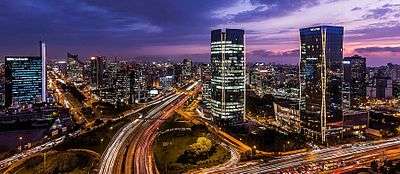
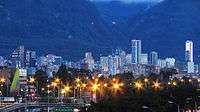
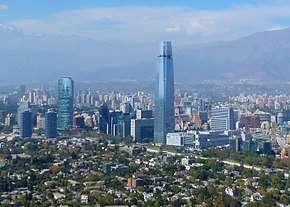
.jpg)
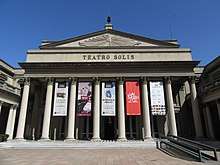
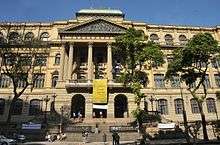



.svg.png)
.svg.png)
.svg.png)
.svg.png)


.svg.png)
.svg.png)
.svg.png)
.svg.png)